Bellevue Park
| Name | Bellevue Park. St. Joseph of Cluny Convent and School |
|---|---|
| Address | Ballinclea Road |
| Year Built | Original property built pre 1787 |
| Exists today | Yes |
| On 1888 map | Yes |
Description by Peter Pearson (1998)
Peter Pearson ‘Between the Mountains and the Sea‘ (1998), pp 62-63
On the west side of Killiney, looking back over Dublin Bay, is Bellevue Park, now occupied by the St Joseph of Cluny convent and school. Bellevue once controlled a large estate which extended as far as Glenageary, where at the top of Adelaide Road there was an entrance and gate-lodge to the house. This long avenue led to a small house which appears on a map of 1816 and which seems to have been rebuilt around 1830 for a banker named Alexander Boyle, of the Dublin firm Boyle, Low and Murray. It is a large, square house with a projecting Ionic portico. The most unusual feature of Bellevue is its circular hall, which carries a gallery or landing and a top-lit dome above. Six curved doors lead to the principal rooms and to the staircase, which itself is of note as it is a cantilevered stone structure of great elegance. The present convent chapel was built as a billiard room by the Anketell Jones family, who owned Bellevue until 1898. The room was designed in the lavish Italianate style of the 1890s. A large mantelpiece, which is an outstanding example of oak carving, is the centrepiece of a very elaborate decorative scheme of panelling and plasterwork. The two large bow windows of the drawing-room and dining-room offer fine views over Dublin Bay.

A sale notice of 1898 gives a full picture of the house and estate. The house was advertised as being a seven-minute walk from Glenageary railway station. The outbuildings comprised three coach houses, two stables and substantial farm buildings. There was a large barn with tyings for twenty cows, and a four-faced clock tower stood between the two yards. The walled garden stood on about one acre, and included a large fernery. Bellevue had two tennis courts in 1898, one grass and one surfaced in `asphalte’.
During the ownership of the Blacker Douglas family, landed gentry from County Armagh who bought Bellevue in the early 1900s, the model farm and ninety-acre estate was kept up. Most of the curved, brick-lined walls of the enclosed gardens are still standing and were once entered by a carved granite door case which is still there but now blocked up, and which may have been the original entrance of an earlier Bellevue house.
In 1930 the house was owned by David Barry, who was chairman of B and I shipping company, and afterwards became the property of Patrick Belton TD. He sold Bellevue to the order of St Joseph of Cluny who established a school here. The rest of the lands were developed with houses.
Sherrard’s Map of Mapas Estate in 1787
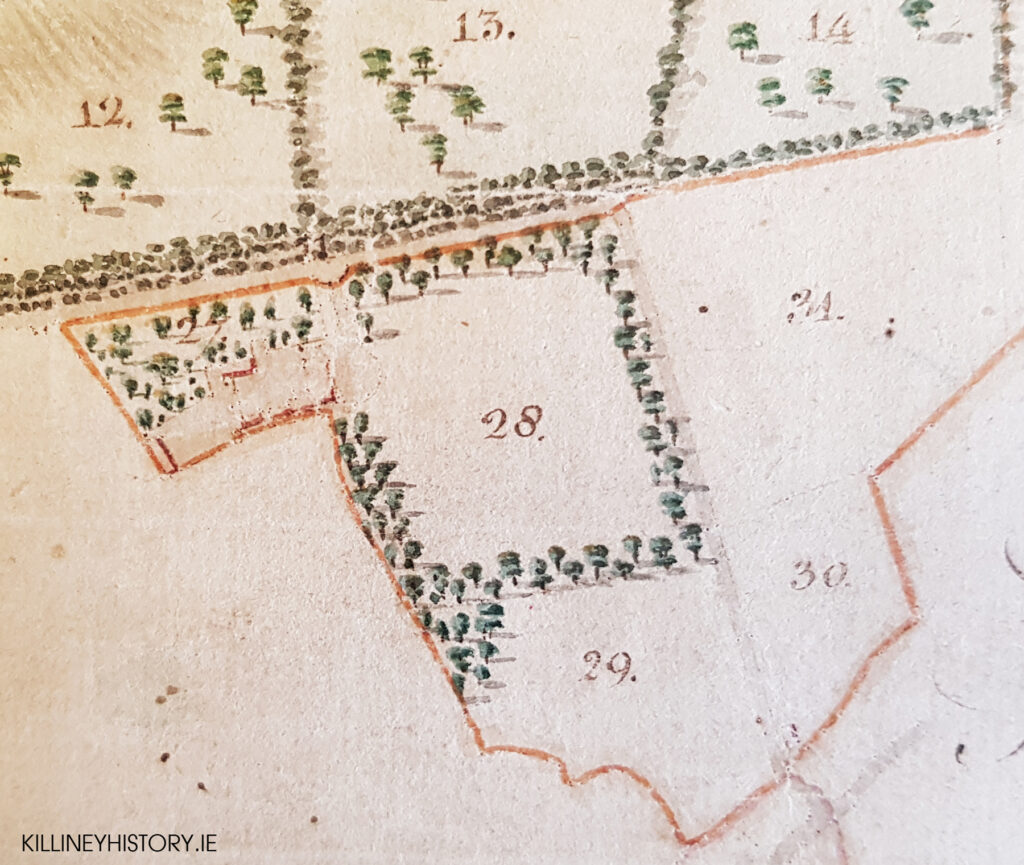
The Estate Map of John Mapas Esq which was titled ‘A Survey of Rochestown’ lists the tenants of the numerous plots which were leased and provides a brief description of the various properties. It has been possible to identify Plot 27 as the site of Belle Vue House, although the name of the house is not provided. The plot is identified as part of Rochestown and was leased to T.J. Medly Esq. and Mrs. Lill along with plots 28 to 33. The property is described as House, Offices (Stables), Yard and Garden on just over 20 acres. You can view the map in more detail here.
The parcels of land which made up the Bellevue park Estate in 1787 are numbered 27-33 on the Sherrard map. The following details are provided:
| Field number/ Area a:r:p | Description | Lessee | Occupant | Townland |
| 27/ 1:0:26 | House Offices Yard and Garden (Bellevue Park House) | T.T. Medly Esq | Mrs. Lill Three lives | Part of Rochestown |
| 28/ 3:2:36 | Lawn and Shrubery, meadow | “ | “ | |
| 29/ 2:0:7 | A Field and Plantation, pasture | “ | “ | |
| 30/ 1:0:24 | A Field, pasture | “ | “ | |
| 31/ 3:0:28 | A Field, pasture | “ | “ | |
| 32/ 4:3:27 | A Field, meadow | “ | “ | |
| 33/ 3:3:17 | A Field, meadow | “ | “ |
Extract from ‘The architecture of John Skipton Mulvany (1813-1870) by Frederick O’Dwyer.
The article appeared in Irish Architectural and Decorative Studies 3 (2000) pp 16-17.
Mulvany’s additions to Alexander Boyle’s Killiney house, Belle Vue (1836), are a competent exercise in the classical style he favoured. There is a double-storey top-lit hall, a feature that was to become a hallmark of his houses, though here, unusually, it is circular, in the Gandon tradition. Boyle was a partner in the stockbroking and banking firm of Boyle, Low and Pim. His partner James Pim junior was treasurer (i.e. general manager) of the D&KR. Mulvany appears to have remodelled the adjacent property Glenageary House for another stockbroker, Halliday Bruce , around 1852. This house was demolished in 1978.
Alexander Boyle relocates to England in 1854 and sells his horses
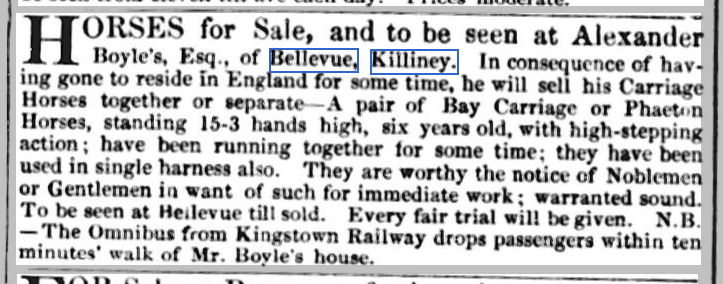
Bellevue Park and Estate in 1866
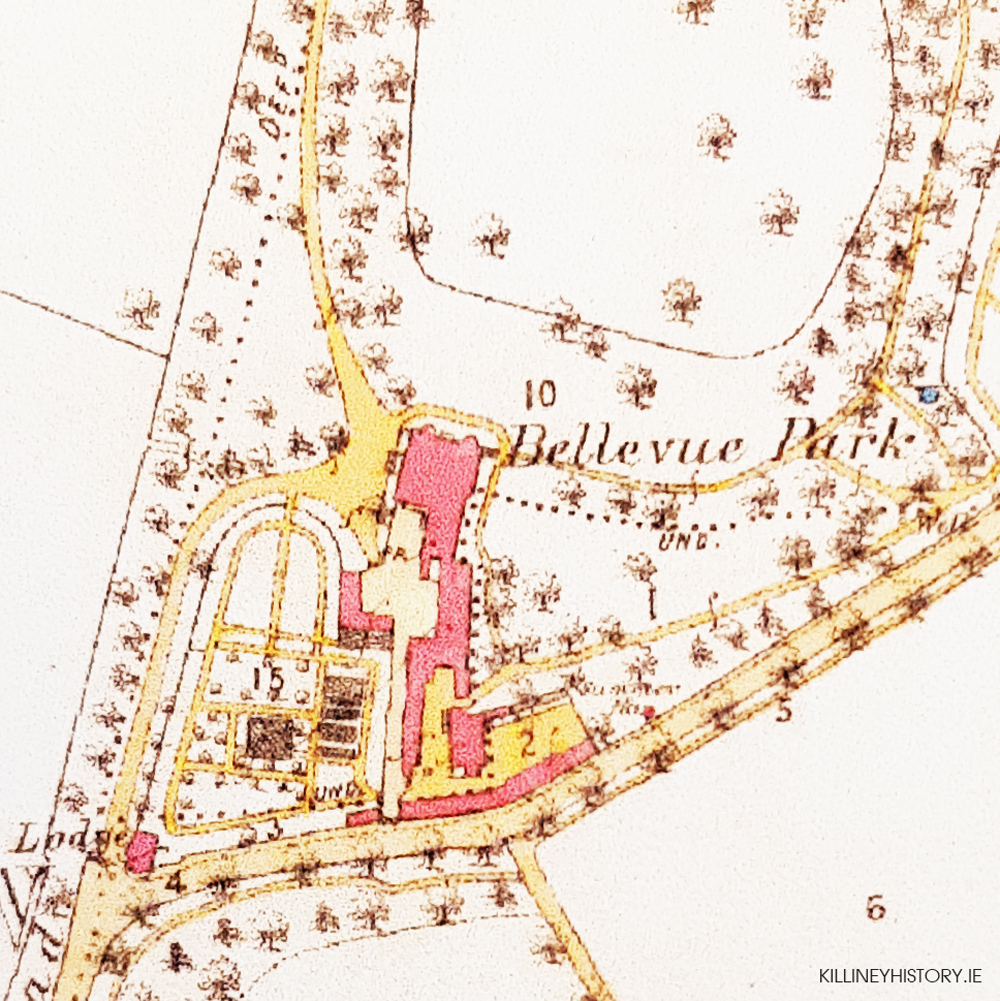
Bellevue Park by Brendan McGovern
This article by Brendan McGovern first appeared in Journal No. 26 of Dun Laoghaire Borough Historical Society, 2017. With thanks to Brendan and DLBHS for allowing us to reproduce the piece here.
BELLEVUE Park (“Bellevue”, French word meaning fine view) was aptly named when it was built in the 1830s, for it commanded panoramic views of Dublin Bay and the tall ships entering and leaving the newly built Kingstown harbour.
Better known today as Cluny Convent, Bellevue Park was a vast working estate stretching to Glenageary and had two entrances, one that is still in use today off Ballinclea Road and one facing the top of Adelaide Road on Glenageary Road Upper. The gate lodge here is now a private house called Bellevue Cottage. Externally Bellevue Park is of no architectural note; but internally all that changes.. as one enters the building through the hall door, the hall is a rotunda, a round room with seven curved doors and one can look up through the railed circular landing above and see the sky through the glass dome in the roof. The Casino in Marino, built circa 1770, has something similar and may have been the inspiration for this in Bellevue Park. The other unusual feature is the wooden carved panelling in what was the billiard room and is now the resident nuns’ chapel – and the cantilever staircase.
Until 1890 the Anketell Jones family resided here and Henry Anketell Jones was responsible for installing the carved oak panelling. In his later life he lived here with his common law wife, Sarah Savage. In the late 1890s Maxwell Vandeleur Blacker Douglas and family moved from Armagh to Bellevue Park. He was an ex-British army officer, a justice of the peace and a deputy lieutenant. They had three children and their eldest son, Robert St John Blacker Douglas who was a lieutenant in the Irish Guards, was killed in action in 1915.
A private, James Brady of the 2nd Battalion of the Royal Dublin Fusiliers, also gave Bellevue Park as his address, so one presumes he or his parents worked on the estate. He too was killed in action in 1916.
David Barry, managing director of B&I Shipping, lived here in the early 1930s and sold the house on to Patrick Belton. Born in County Longford in 1885, Patrick went to work in London and got to know Arthur Griffith and Michael Collins. He returned to Dublin and worked in the Irish Land Commission. He was suspended from this post on suspicion of taking part in the 1916 Rising, and was reinstated in 1918. He was elected as a Fianna Fáil TD in 1927, and was expelled from the party six weeks later for taking the oath of allegiance and entering the Dáil. In 1936 Paddy Belton became President of the newly formed Irish Christian Front, a group set up to help the pro-Franco side in the Spanish civil war. It was also pro-catholic and anti-communist. His rallies would draw vast crowds of up to 30,000. All this dwindled when he lost his seat in the Dáil in 1937. He died in Bellevue Park in 1945.
Three of his four sons became members of the Oireachtas, and his son Paddy became Lord Mayor of Dublin. His granddaughter Avril Doyle became a TD, a senator and later an MEP, and fondly recalls playing on her grandfather’s farm in Killiney.
In 1956 the Sisters of St Joseph of Cluny bought Bellevue Park and some of the estate and proceeded to build a girls’ primary school and a girls’ secondary school. The primary school closed in 2012.
The rest of the estate was carved up between various builders and Avondale Road, Arnold Park, Avondale Crescent, Hillcourt Road, Sion Road were built to mention a few – and of course Bellevue Road. I wish to thank Sister Clare of the Sisters of Cluny for the photograph and information.
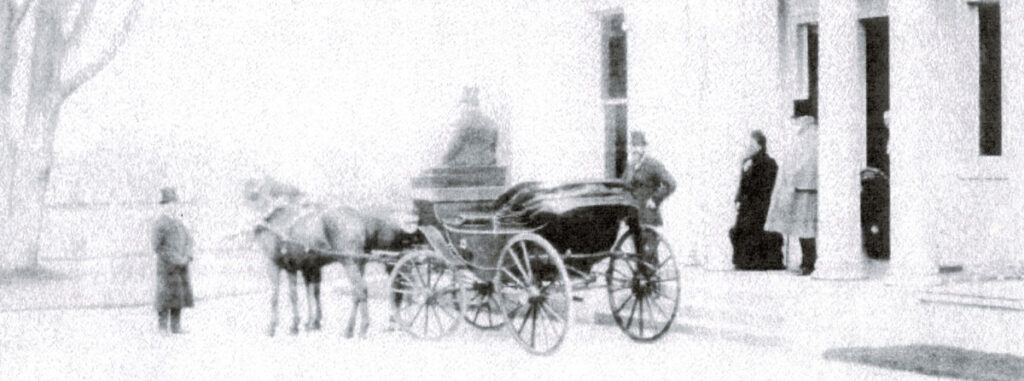
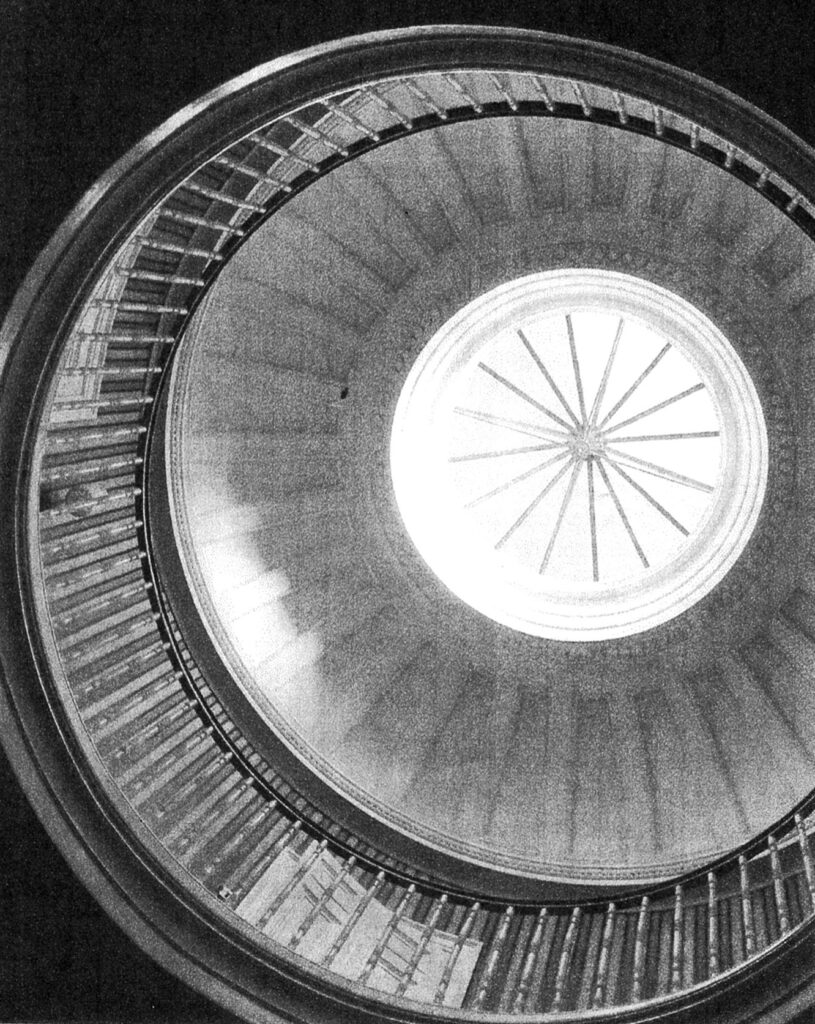
Society event of 1893 at Bellevue Park hosted by Mrs. P.W. Anketell-Jones

M. V. Blacker Douglass c.1905-1923 (of Bellevue Park, Elm Park co. Armagh, Tullahennel co. Kerry and Grace Hall, co. Down)

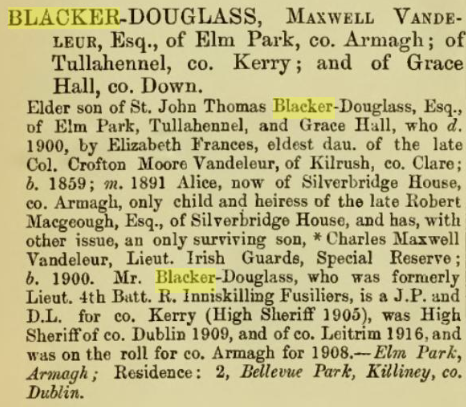
Belton Dairy Farm strike of 1944
Saothar , 1986, Vol. 11 (1986), Daniel G. Bradley. Speeding The Plough: The Formation of the Federation of Rural Workers, 1944-1948. p.43
The Association recommended all Dublin farmers to accept the terms, whether they were members of the Association or not. The agreement gave an increase of 4/- for men, 2/- for youths, a 50 hour week, which meant a weekly half-day, and a full day’s holiday with pay on each church holiday and public holiday. There was to be payment of time and a quarter for any hours worked over 50, and payment for casuals other than those engaged in threshings was to be 10/- for a 9 hour day where work was less than the normal five and a half days.
One prominent employer refused to accept the terms and a strike followed on his farm. That strike is worthy of attention because it heralded the return of farm strikes in Ireland, and because it illustrates the opposing perspectives at the time. Patrick Belton farmed over 400 acres in Killiney. He had 300 acres of tillage in 1944, 130 to 140 first class dairy cows which supplied 200 gallons of milk to the city daily, according to his own calculations. He also had another farm at Drumcondra. Thirty male labourers were employed on the Killiney farm. On 9 October, 1944, twenty five of these workers plus twelve girls aged 15-17 employed as potato pickers went on strike when the pay increase and the half day were refused. The response was the placing of large advertisements in the daily newspapers calling a meeting of farmers to form a new association, and also calling for government protection from the ‘destroyers of food’. As a result the National Agricultural Association was formed and a full-time organiser appointed
When the dispute was two and a half weeks in progress Belton claimed the strike was over, but the WUI insisted that up to thirty male and female workers were still affected. In a letter to the Irish Times Belton ignored the pickets and declared: ’My farm at Killiney is fully staffed, and I have no room for any more workers, all my regular staff at Killiney have returned to work with the exception of 3, the talk of 20 or 30 hands still on strike here is pure fiction.’
The WUI then tried to prevent his produce from being sold in the Dublin markets, which led to five members of the union being detained in the Bridewell following a demonstration against a stall-holder who handled produce from the Killiney farm.
There was clearly a wide gap in communication in the dispute which was seen in widely divergent terms. None of the newspaper advertisements made any reference to the half day and public holidays, which were central issues from the workers’ viewpoint. Eventually Belton claimed the strike occurred in the first place because the wages he paid were too high, and he placed a large box advertisement in the newspapers with the challenge that he would back the accuracy of his statement with £100, provided ‘Deputy Larkin who led the strike, backs his statement with a similar amount, the loser to hand over his £100 as a bonus to my farm workers’
Bellevue Park Estate in 1958
This photograph was taken just as work had begun on building the Bellevue estate at the Glenageary end of the partially constructed Avondale Road . At this stage the original sweeping entrance driveway is still evident but the section at the main Glenageary Road entrance has been built over. Rochestown Domain is as yet untouched by development and has barely changed since it was laid out in the 18th century.
Records from Thom’s Directory
| Year | Occupant | Source |
| 1787 | T.J. Medly Esq. and Mrs. Lill | Map of Estate of John Malpas by Sherrard |
| 1834 | Alexander Boyle | Watson’s Almanack (Bellview) |
| 1847-52 | Alexander Boyle | Thom’s Directory (Bellevue Park) |
| 1856-1880 | H. Montray Jones | Thom’s |
| 1884-1888 | H.M. Antekell Jones | |
| 1892-1900 | Mrs. H.M. Antekell Jones | |
| 1905-1923 | Maxwell V.B. Douglas JP DL and co. Kerry | Thom’s |
| 1924-1930 | David Barry | |
| 1932-1937 | David Barry OBE | |
| 1940-1943 | Patrick Belton TD | |
| 1947 | Mrs. P. Belton | |
| 1950-1954 | Doctor R. Belton | |
| 1960 | Convent of St. Joseph of Cluny |

